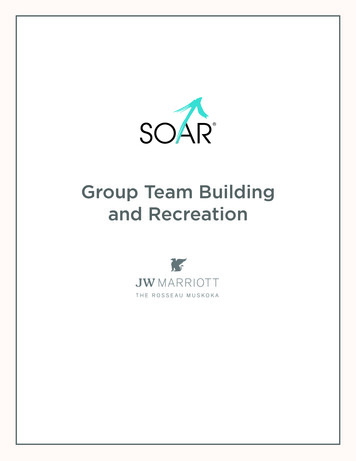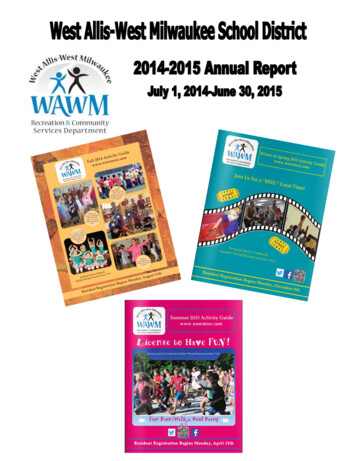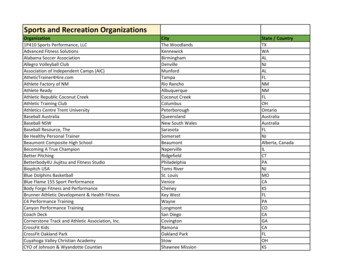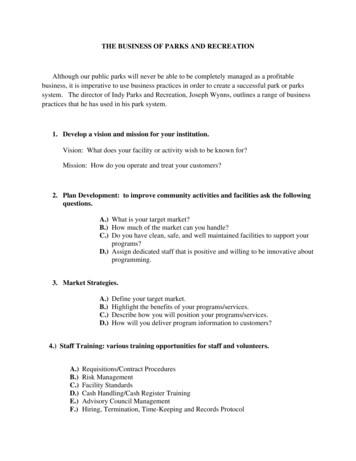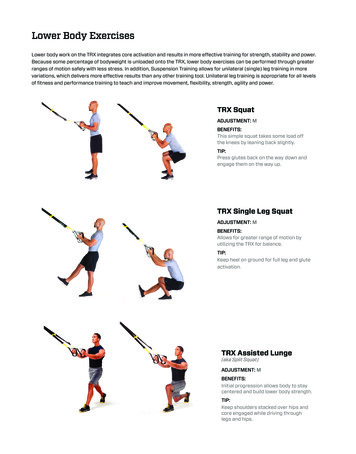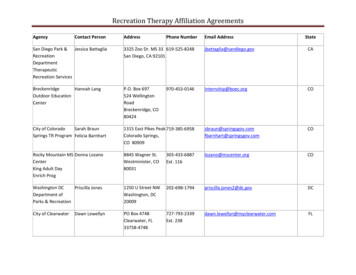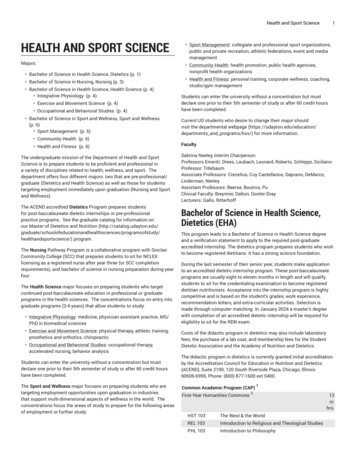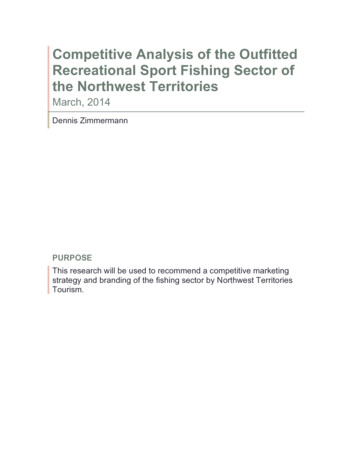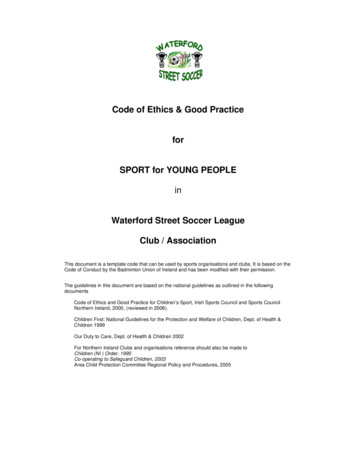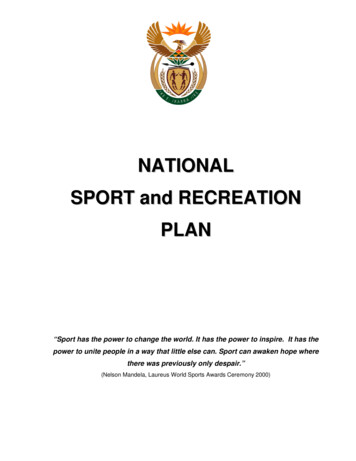
Transcription
NATIONALSPORT and RECREATIONP LA N“Sport has the power to change the world. It has the power to inspire. It has thepower to unite people in a way that little else can. Sport can awaken hope wherethere was previously only despair.”(Nelson Mandela, Laureus World Sports Awards Ceremony 2000)
TABLE OF CONTENTSEXECUTIVE SUMMARY4SECTION 1: INTRODUCTION8BACKGROUNDPREAMBLEPROCESS OF DEVELOPING THE NATIONAL SPORT AND RECREATION PLAN (NSRP)LEGAL FRAMEWORKVISION 2030811121516EXPECTED OUTCOMES AND “IDEAL FUTURE” FOR A SOUTH AFRICAN SPORTS SYSTEMBOOKMARK NOT DEFINED.VISION STATEMENTSTATEMENT OF PURPOSE (MISSION)ERROR!CORE VALUES OF THE ENVISAGED SPORTS SYSTEMSECTION 2: COMPONENTS OF NSRPACTIVE NATIONRECREATIONSCHOOL SPORTPARTICIPATION PROMOTION CAMPAIGNSWINNING NATIONTALENT IDENTIFICATION AND DEVELOPMENTATHLETE AND COACH SUPPORT PROGRAMMEDOMESTIC COMPETITIONSINTERNATIONAL COMPETITIONSRECOGNITION SYSTEMENABLING ENVIRONMENTFACILITIESCLUBSSPORTS COUNCILSATHLETES’ COMMISSIONCOACHES’ COMMISSIONADMINISTRATORS AND TECHNICAL OFFICIALS’ COMMISSIONACADEMY SYSTEMSPORTS HOUSESPORTS INFORMATION CENTREEDUCATION AND TRAININGVOLUNTEERSINTERNATIONAL RELATIONSFINANCIAL 0414243444545472
SPORTS BROADCASTING AND SPONSORSHIPSTRANSVERSAL ISSUESTRANSFORMATIONPRIORITY CODESETHICAL ENVIRONMENTGEO-POLITICAL SPORTS BOUNDARIESAMATEUR VS PROFESSIONAL SPORTSPORT AS TOOLSPORTS TOURISMSPORT FOR PEACE AND DEVELOPMENTSPORT AND THE ENVIRONMENTSPORT AND NATIONAL GOVERNMENT PRIORITIESSECTION 3: ROLES AND RESPONSIBILITIESGOVERNMENTTHE SPORTS CONFEDERATIONSECTION 4: , MONITORING AND BUDGETING CYCLESCOLLABORATIVE AGREEMENTSRESTRUCTURINGMARKETING AND COMMUNICATION66666767ACRONYMS AND ABBREVIATIONS68REFERENCE DOCUMENTS703
EXECUTIVE SUMMARYThe National Sport and Recreation Plan (NSRP) will be an eight year sustainableimplementation plan for the sport and recreation policy framework as captured in the WhitePaper. Whilst it is envisaged that the White Paper will remain relevant until 2019, the NSRPwill be closely monitored annually to identify any hindrances which may be negatively impacton implementation and will be reviewed in 2020.The NSRP is the end product of a structured process of broad consultation and robust debatewith a diverse and encompassing group of stakeholders representing the South African sportand recreation sector.The NSRP commences with a background reflecting historically where we come from andsome of the significant milestones achieved in establishing a democratic, non-racial sportssystem for our country.The structure of the document is outlined in the preamble where-after attention is given to the process of developing the NSRP and the legal frameworkregulating the NSRP.When describing the Vision 2030 (linked to the National Development Plan of South Africa)the expected outcomes and ideal future for a South African sports system is expressed. Abold vision statement is given followed by a clear statement of purpose.Section 1 of the NSRP concludes by identifying the core values desired to guide theimplementation of the NSRP.Section 2 is essentially the nucleus of the NSRP as it provides details of the 3 core pillars ofimplementation: (1) active nation (2) winning nation (3) enabling environment. These pillarsare underpinned by transversal issues and utilising sport as a tool to achieve national andglobal priorities.When building an active nation it is clear that no country can expect to achieve and sustainsuccess at the elite level without a strong participation base in the community, because that is4
where every champion has their beginning. The NSRP specifically focuses on the followingstrategic objectives to assist with broadening the base of sport and recreation in South Africa: To improve the health and well-being of the nation by providing mass participationopportunities through active recreation. To maximise access to sport, recreation and physical education in every school in SouthAfrica. To promote participation in sport and recreation by initiating and implementing targetedcampaigns.In developing a winning nation it is important to improve international sports successes bysupporting athletes at all levels of participation. The following strategic objectives aim toachieve this: To identify and develop talented athletes through the implementation of a structuredsystem. To improve the performances of athletes and coaches by providing them with access to acomprehensive range of support programmes. To develop talented athletes by providing them with opportunities to participate and excelin domestic competitions. To develop elite athletes by providing them with opportunities to excel at internationalcompetitions. To acknowledge the achievements of individuals and teams within the South African sportand recreation sector through the establishment of a recognition system.The term “athlete” in the NSRP is a generic reference for all people participating in sport andrecreation.Achieving an active and winning nation is underpinned by an enabling environment withthe following strategic objectives: To ensure that South African sport and recreation is supported by adequate and wellmaintained facilities. To provide formal sports participation opportunities through an integrated and sustainableclub structure.5
To integrate the development of South African sport at provincial and local levels throughfunctional sports councils. To provide athletes with a forum to address their needs. To support and empower South African coaches. To support and empower South African administrators and technical officials. To support the development of South African sport through a coordinated academysystem. To provide National Federations (NFs) with administrative and governance supportthrough the medium of a Sports House. To empower the sport and recreation sector with relevant information through theestablishment of a Sports Information Centre. To empower the human resource base through the provision of accredited educationand training programmes. To empower volunteers to adequately support the South African sports system. To ensure that South African sport and recreation benefit from strategic internationalrelations. To secure and efficiently manage financial resources to optimally support sport andrecreation. To capitalise on the impact that broadcasting and sponsorship have on thedevelopment of sport and recreation.Integral to campaigning for and supporting an active and winning nation are five transversalissues which permeate every building block of the NSRP, and are considered non-negotiableimperatives. The transversal issues have the following strategic objectives: To ensure that equal opportunities exist for all South Africans to participate and excel insport and recreation through the adoption of deliberate transformation initiatives. To maximise the return on investment by prioritising sporting codes best suited tobroadening the participation base or achieving international success. To ensure that the South African sport and recreation sector is globally respected for itshigh values and ethical behaviour. To contribute to improved governance in sport through an alignment of provincial sportsboundaries with the country’s geo-political boundaries.6
To protect the rights and interests of talented athletes under 18 years of age by providingclear guidelines on amateur and professional sport.Section two concludes with a review of using sport as a tool to support and achieve a diverserange of national and global priorities with the following strategic objectives: To use sport and recreation as a medium to attract tourists to South Africa. To use sport and recreation as a mechanism for achieving peace and development. To ensure that participation in sport and recreation activities is conducted in anenvironmentally sustainable manner and to use sport as a tool for communicatingenvironmental messages and encouraging actions to clean up the environment. To capitalise on the numerous benefits derived from participating in sport and recreationas a mechanism towards achieving and supporting the priorities of NationalGovernment. This includes among others: To build the sports economy to effectively contribute to shared economic growth anddevelopment in South Africa, including through the creation of decent work. To use sport and recreation as a medium for building social cohesion and sustainablecommunities. To harness the nation-building characteristics of sport and recreation. To use sport and recreation as a medium of building a healthy nation.Section 3 of the NSRP provides clarity on the demarcation of roles and responsibilities ofthe stakeholders in the sector.Section 4 offers a conclusion that details a way forward in terms of: Planning, monitoring and budgeting cycles. Collaborative agreements Coordination and cooperation Restructuring Marketing and communication.7
SECTION 1: INTRODUCTIONBackgroundThe apartheid era in South Africa, which ended in 1994 when the country held its first everdemocratic elections, was characterised by numerous discriminatory laws and practicesbased on race. The sport and recreation sector did not escape the scourge of legalised,institutionalised and non-institutionalised racial practices.The vast majority of Blacks (i.e. African, Indian and Coloured people) did not have equalaccess to competitive or recreational sports opportunities at school or community levels.There was little or no investment into sports infrastructure, equipment, attire, development,talent identification and/or activities for previously disadvantaged population groups. At thesame time, apartheid South Africa was subjected to international sporting sanctions whichisolated the country and its White athletes from international competition.Irrespective of these racial practices various sports organisations tirelessly fought forestablishing a sports system free of discrimination and that would provide equal participationopportunities for all South Africans. This was done through the dedicated leadership and workof organisations such as the South African Council on Sport (SACOS), the South African NonRacial Olympic Committee (SANROC), National Olympic Committee of South Africa (NOCSA)and the National Sports Council (NSC).In 1993, the NSC convened a “Vision for Sport” national sports conference. The NSC hadbeen established to unify sports structures; develop a national sports policy and facilitateequitable development of sport in a democratic South Africa.The sports developmentpyramid or continuum of foundation, participation, performance and excellence phases wasmooted at this conference. This approach as well as the outcomes of the conference wasincluded in the democratic government’s first discussion paper on sport entitled “Getting theNation to Play”.The advent of democracy in 1994 ushered in significant changes to policies and legislationthat impacted on all sectors of society and that addressed all aspects of political, social-8
economic and human rights of people.All the changes were driven by the democraticgovernment’s goal of transforming South Africa into a free, just and equitable society thatmeets the needs of its people by creating a better life for all.The new democratic government of South Africa, under the leadership of the African NationalCongress (ANC) as the ruling party, consolidated the efforts of the SACOS, SANROC and theNSC by building a democratic sports system that addressed the imbalances of the past. Theprocess of unifying South African sports bodies was institutionally achieved in the earlynineties.Given government’s understanding of the important socio-economic and developmental roleof sport, this sector was identified as needing to be transformed to, amongst others, increaseand ensure equitable access to all sporting opportunities; develop and build the sportseconomy; increase the social development impact of sport; harness and further develop thecompetitive abilities of South African sports persons to participate in international sportscompetitions and for the sector to reflect the demographics of the country.In 1996, the late Minister of Sport and Recreation, Mr S.V. Tshwete released a White Paperon sport and recreation. The White Paper was the first official policy on sport and recreationsince the establishment of this Ministry on 1 July 1994. Five years after the first White Paperon sport and recreation was released, it was revised and updated to take into account newdevelopments in the sport and recreation sector.At the end of 2000, the then Minister of Sport and Recreation, Mr B.M.N. Balfour appointed aMinisterial Task Team (MTT) to investigate factors that negatively impact on South Africa’sperformance in high performance sport at an international level. This initiative was partlymotivated by the perception that South Africa had performed poorly at the Sydney 2000Olympic Games. Although the MTT was tasked with focusing on high performance or elitesport; its report and recommendations addressed improving the overall sports system in SouthAfrica.The Cabinet approval of the MTT report towards the end of 2003 paved the way for therationalisation of South African sport with a reduction of seven umbrella bodies to only two,namely a fully fledged Department of Sport and Recreation to deal with mass participation and9
a non-governmental sports organisation to assume the coordinating responsibility for highperformance sport. The former entities at a macro-level comprised the following: Sport and Recreation South Africa (SRSA) South African Sports Commission (SASC) National Olympic Committee of South Africa (NOCSA) Disability Sport South Africa (DISSA) South African Commonwealth Games Association (SACGA) South African Students Sports Union (SASSU) United School Sports Association of South Africa (USSASA).In 2004, the South African Sports Commission Act was repealed and the South African SportsConfederation and Olympic Committee (SASCOC) was established.It is important to note that where there is reference to “SASCOC” in the NSRP it includes theNational Federations as well as the Provincial Sports Councils affiliated to SASCOC.The 2001 revised White Paper does not reflect the institutional changes made in 2004. Nordoes it adequately reflect government’s understanding of transformation of the sport andrecreation sector based on the sector’s role in social development, the sports economy, sportas a right, sport in development and peace, sport and the environment, an outcomes-basedapproach to governance and the proactive role of a developmental government.The third revision of the White Paper addresses the afore-mentioned issues. The process ofupdating the White Paper was finalised in 2011 together with the development of a Road Mapthat outlined priority areas for sport and recreation. These documents form the basis for thedevelopment of government’s first ever National Sport and Recreation Plan, nurturing avibrant sports system that encourages growth and development of the sports sector and theequitable delivery of sport to all to ensure that South Africa is both “An Active and a WinningNation”.10
PreambleIn South Africa we have experienced how sport can benefit from and exploit social andeconomic opportunities. This was experienced, for example, when South Africa won theRugby World Cup in 1995 and 2007 and more specifically during the 2010 FIFA World CupTM.To build on these positive experiences it is essential to have an integrated, coordinated,functional and performance oriented sports system in place. The NSRP is the foundation ofsuch a system. The strategic focus of the NSRP is to reconstruct and revitalise the deliveryof sport and recreation towards building an active and winning nation that equitablyimproves the lives of all South Africans.The NSRP is the implementation plan of the policy framework for sport and recreation ascaptured in the revised White Paper. In other words the White Paper determines the “what”and the NSRP the “how”.Worldwide strategies are focused on increasing levels of participation in sport andrecreation, as well as achieving success in high profile sports.The benefits of thisapproach, for South Africa, are reflected in a document entitled a “Case for Sport”, publishedby Sport and Recreation South Africa (SRSA) in December 2009.The NSRP not onlyfocuses on these two internationally recognised pillars for any successful sports system butextrapolates on the enabling environment that is required to give effect to the two focusareas.At the heart of the NSRP is a Transformation Charter and a multi-dimensionalTransformation Performance Scorecard. The purpose of the Charter is to transform thedelivery of sport in South Africa to reap benefits such as the establishment of a competitiveand demographically representative sports system guided by the values of equal opportunity,fairness and just behaviour, equitable resource distribution, empowerment, and affirmation.The implementation, management and monitoring of sport’s transformation is supported by ascorecard that will enable the sports system to measure where it is in its transformationjourney, whether it is improving and to set targets.The NSRP provides for the different stages of a long term participant development plan.This includes, among others the physical, mental, emotional, and cognitive development of11
athletes within the entire sports development continuum, including athletes with a disability.(Also see the reference document “South African Sport for Life – Long Term ParticipantDevelopment”.)In all the activities, as outlined in the NSRP, special emphasis is put on the inclusion,empowerment and promotion of government’s priority groups, namely the youth, the aged,women, rural communities and people with disabilities.Without a coordinated, integrated and aligned national sports system within which allcomponent parts are focused towards a common set of goals and objectives, the potentialvalue of sport to the South African society cannot be fully realised. To ensure a collectivebuy-in and to streamline implementation towards common objectives, it is important that roleplayers align their strategic and business plans with the NSRP and that planning cycles,as far as is possible, are also aligned.Due to the complexity and broad application of the NSRP it is foreseeable that it will beimplemented in consecutive phases. The components of each phase will supplement eachother and enrich previous phases. A thematic approach is envisaged with relevant themesbeing adopted each year.Process of developing the National Sport and RecreationPlan (NSRP)The NSRP represents a truly “bottoms-up” plan for transforming the delivery of sport andrecreation in South Africa. It was developed through an intense and thorough consultativeprocess with robust debates and constructive contributions from all role-players that comprisethe sport and recreation sector in the country. Highlights of the process in 2011 were: At a Departmental strategic workshop from 10 – 12 January delegates agreed to organisea National Sport and Recreation Indaba to finalise South Africa’s first NSRP. Minister Fikile Mbalula appointed a Steering Committee to oversee the NSRP process,with Deputy Minister Gert Oosthuizen as the Committee Chairperson. The first meeting ofthe Steering Committee was held on 4 February. All Provinces, the South African Local12
Government Association (SALGA), SASCOC and other identified role-players wererepresented on the Steering Committee. The concept of the NSRP and Indaba was launched through the media to stimulate publicdebate on 5 April. Also in April the SRSA website was used to encourage public participation and inputs tothe NSRP. An “Indaba Opinion Piece” on the National Indaba was also released tostimulate debate. The draft NSRP was
2 table of contents executive summary 4 section 1: introduction 8 background 8 preamble 11 process of developing the national sport and recreation plan (nsrp) 12 legal framework 15 vision 2030 16 expected outcomes and “ideal future ” for a south african sports system error! bookmark not defined. vision statement 17 statement of purp

